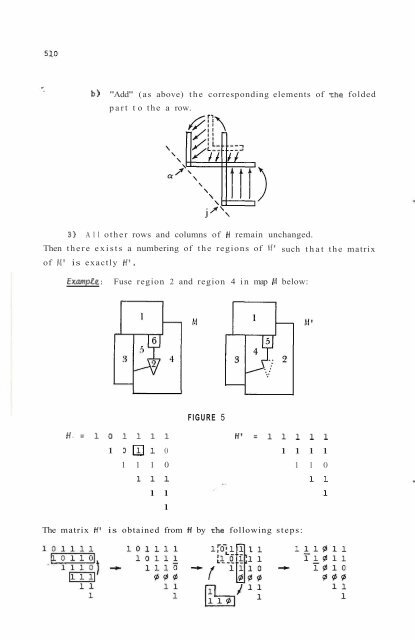You also want an ePaper? Increase the reach of your titles
YUMPU automatically turns print PDFs into web optimized ePapers that Google loves.
) "Add" (as above) the corresponding elements of e he foldedand finallypart to the a row.11 11111111 1 0111It should be noted that even though one row and one column disappeared,this fusion "swallows up" zeroes in the remaining rows and columns.The presence of more one's tends to increase the number of colorsneeded to normalize the matrix. Hence the proof of the following con-3) All other rows and columns of H remain unchanged.jecture, as indicated earlier, would solve the four color problem.Then there exists a numbering of the regions of hf' such that the matrixof M' is exactly H'. Conje.&tu~e.: Given an n + 1 matrix which requires a minimum of 5E X : Fuse region 2 and region 4 in map M below:colors to be normalized, then there exists one fusion of regions suchthat the resulting n n matrix requires 5 colors to be normalized.The above, and this we believe is the merit of this paper, is voidof any geometric concept and constraint: Given a matrix which requires5 letters to be normalized, fuse two rows (in the sense of the precedingtheorem -- without reference to geometry) such that the resulting matrixstill requires 5 letters. The efforts of the author toward settling theabove conjecture have not yet produced satisfactory results.H . = 1 0 1 1 1 11 om1 01 1 1 0I l l111FIGURE 5H 1 = l l l l l11111 1 0The matrix H' is obtained from H by the following steps:REFERENCESHarary, F. (editor), Graph Theory and Theoretical Physics, AcademicPress, New York, 1967.Harary, F., Graph Theory, Addison Wesley, Reading, Mass., 1969.Liu, C. L., Introduction to Combinatorial Mathematics, McGraw-Hill,New York, 1968.Marshall, C. W., Applied Graph Theory, Wiley-Interscience, New York,1971.May, K. 0. , "The Origin of the Four Color Conjecture ," Iris, 56,(19651, pp. 346-348.Ore, 0. , The Four Color Problem, Academic Press, New York, 1967.Ore, 0. and Stemple, Joel, "Numerical Methods in the Four Color Problem,"Journal of Combinatorial Theory, 8, (1970), pp. 65-78.
















